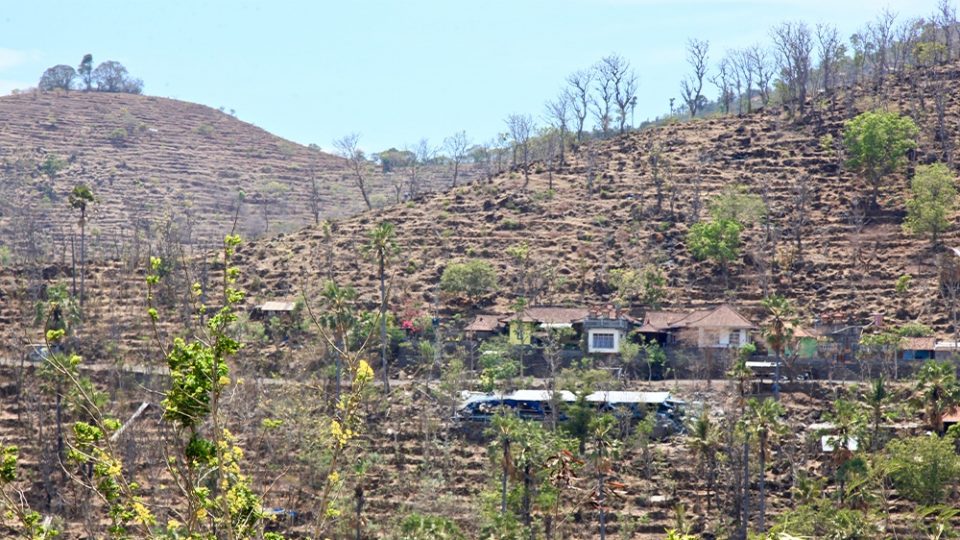The diversion of water to urban areas on the densely populated island of Bali, and the overuse of groundwater by hotels serving foreign and domestic tourists in recent years are disrupting the Balinese water system.
Since the ninth century, the Balinese people have used subak, a sophisticated irrigation system that diverts water from channels to rice fields and back to water crops. It also embodies the Balinese Hindu philosophy of harmony between people, nature, and the spiritual realm.
The island is now facing a water crisis that is threatening food security, traditional culture, and quality of life due to drought, according to the International Federation of the Red Cross it is affecting 50 million people across Indonesia.
Anton Muhajir, a local journalist who has been covering the water crisis in Bali for a decade, believes that Bali is in real danger. “Some of my friends have had to move from their ancestral homes in Denpasar because the water in their wells has turned salty. At Jatiluwih, where thousands of tourists go each day to see the most beautiful rice terraces of Bali, farmers are using plastic pipes to pump in water that they have to buy in the south because the springs in the mountains are drying up.”
IDEP Foundation is an Indonesian NGO focused on sustainable development. The Fundraising Officer, Dewi Anggraini Puteri, has said that 65 percent of the island’s water is used for tourism.
“The subak system is still being used by every village in Bali, but now they’re fighting with people who work in tourism because their water sources are drying out and lots of paddy fields are disappearing as a result,” she said.
Stroma Cole, a senior lecturer in tourism geography at the University of the West of England has previously authored a scientific paper citing various sources including Indonesia’s own Environmental Protection Agency, which found 260 of Bali’s 400 rivers had run dry – Lake Buyan, and the island’s largest water reserve had dropped 3.5 metres. A more recent map shows saltwater is now intruding at many different points all around the island.
“Bali’s freshwater scarcity problem is only expected to get worse unless there is a paradigm shift in the mass tourism model and they embrace quality, sustainable tourism,” Cole said.
Vibeke Lengkong of I’m an Angel, a local charity that provides water aid to villages in drought-stricken parts of Bali, estimates that the average tourist uses between 2,000 and 4,000 litres of water a day, a figure based on daily water use in luxurious resorts and villas, as well as for swimming pools, gardens and golf courses and building more tourist infrastructure.
“Authorities have exacerbated the crisis. The government has built pipelines to divert water up there from the central lakes, but there’s no water flowing in the pipes because of a lack of funding and corruption that impacts every level of government in Bali,” Lengkong said.
“We’ve built 10 recharge wells in the centre of the island and are planning to build 126 more. The government is also building some in the south. But these are only pilot programmes. We need thousands to restore the water table in Bali to a healthy level,” said a programme officer for water projects at IDE, Sayu Komang.
Indonesia’s Meteorology, Climatology, and Geophysics Agency (BMKG) is warning of the coming wet season, which normally begins around now, but will probably not start in Karangasem and two other poor regencies in Bali’s north and west until early next year.
Seraya Timur on Bali’s east coast is one of dozens of villages already suffering. Most do not even have access to enough clean water to drink, bathe and cook.
Wayan, a shopkeeper in Seraya Timur, said he only has water for three days a week. On other days, he draws water from a 3,000-litre tank that cost him $200. “I was born in this village and lived here all my life. It’s always been dry. But never like this,” he said.
Some 50 kilometres to the north is Tianyar Timur, a village on the slopes of Mount Agung. It’s even drier: there are no taps at all. Farmers must rely on a series of 5,000 rainwater catchment tanks installed by I’m An Angel earlier this decade.
But with not a drop of rain since April, the tanks are bone dry and the only way to refill them is with water trucks provided by the state – on occasion.
“The villages in the north, east, and west aren’t dry because of drought. They’re dry because of politics, because of choices that are being made,” said a civil engineering lecturer at Bali State Politeknik, Lilik Sudiajeng. “But water from the lakes can be equitably distributed across the island, or it can be massively overused for tourism, as is happening now. They’re damming rivers to divert water to the south whereas they could be directing it up north.”
Source: Al Jazeera
Image: Al Jazeera




